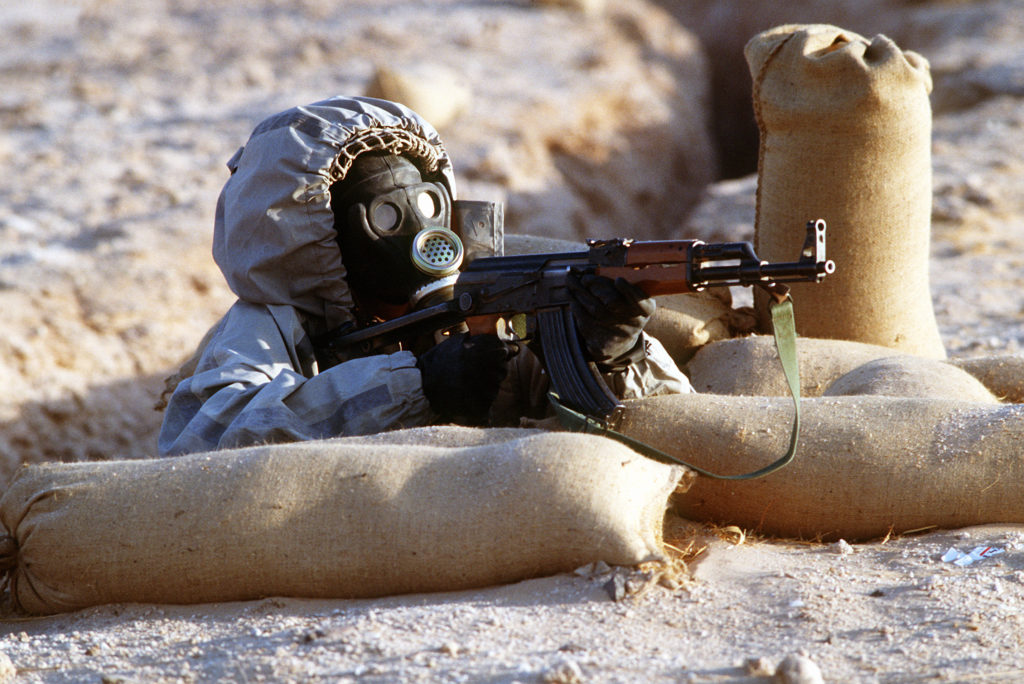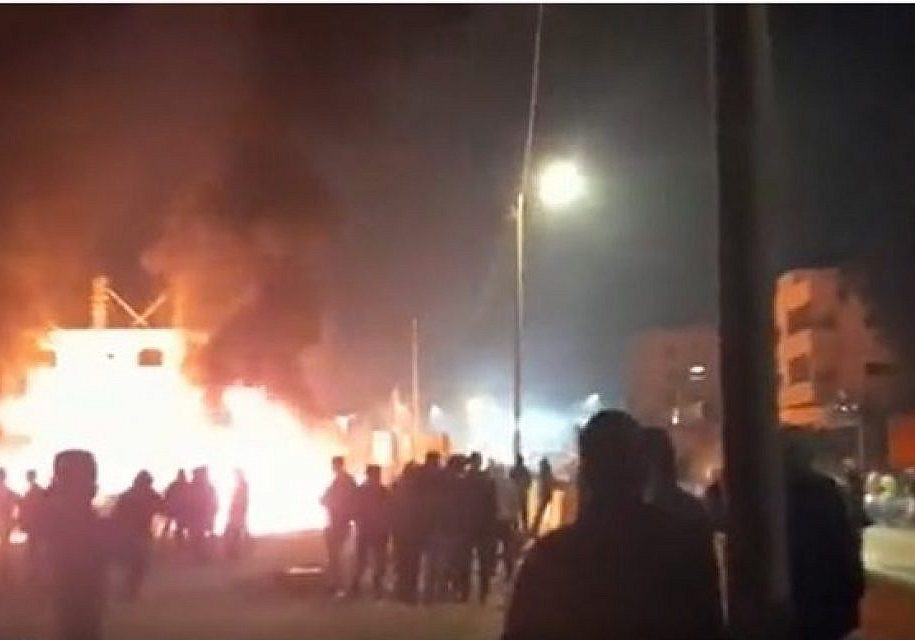FRESH AIR
UPDATES
Syria chemical attack highlights the ugly reality that the Middle East is turning into a chemical weapons free-for-all
April 5, 2017 | Shmuel Levin

Author: Shmuel Levin
Once again, the world has woken up to another chemical weapons atrocity in Syria, with numerous heart-rending videos showing children gasping and struggling to breathe, if not killed outright. Early indications suggest that the attack likely involved sarin nerve gas.
But didn’t the Obama Administration successfully eliminate those chemical weapons under a deal struck with Russia in 2013? And didn’t UN Resolution 2118 decide that “the Syrian Arab Republic shall not use, develop, produce, otherwise acquire, stockpile or retain chemical weapons”?
The reality that Syria has maintained much of its chemical weapons capacity is not a new revelation.
Two years ago the Wall Street Journal ran a long piece deconstructing the methods of inspection carried out by the international inspectors who visited Syria in May 2014. Here are some of the highlights:
- To begin with, the inspectors were only given access to sites that the Assad regime chose, and only with 48-hours notice. The inspectors had the power to request access to other sites, but did not do so because Western governments “didn’t want a standoff with the regime.”
- When the inspectors “half-jokingly suggested” that they be allowed to visit a Syrian Scientific Studies and Research Center – long suspected by US and Israeli intelligence agencies of running chemical weapons facilities – the facility’s directors told them that they had only “done research on detecting chemical agents and on treating people exposed to toxins”, and then treated them to a PowerPoint presentation on the centre’s work in oncology and pesticides.
- Other sites were not visited because they were deemed “too risky” to approach. In one case, inspectors did try negotiating safe passage with rebel leaders over Skype, but failed.
- The inspectors were suspicious of Syria’s claims that it had destroyed large stockpiles of chemical weapons in the preceding months, when it had taken other countries decades to destroy similarly large stockpiles. But the inspectors did not press the issue because they were worried that it would “compromise their primary objective of getting the regime to surrender the 1,300 tons of chemicals it admitted to having”.
- For the same reason, the inspectors did not ask questions when Syria failed to declare the very same rockets which an earlier UN inquiry had found at the site of the 2013 sarin attack.
- Despite US plans to control the “speed, frequency, and order of deliveries” of the weapons on their way to being destroyed, the head of field operations, Jerry Smith, informed the US that “the Assad regime was calling the shots”.
As the Wall Street Journal concluded back in 2015:
“The CIA had been confident that Mr. Assad destroyed all of the chemical weapons it thought he possessed when the weapons-removal deal was struck. In recent weeks, the CIA concluded that the intelligence picture had changed and that there was a growing body of evidence Mr. Assad kept caches of banned chemicals, according to U.S. officials.”
A history of inaction
In 2012, former US President Barack Obama first set his “red line” for the Assad regime: where “we start seeing a whole bunch of chemical weapons moving around or being utilized”.
Then, in 2013, Obama backtracked and decided not to retaliate against Assad’s use of sarin nerve gas. Instead Obama hailed the “important achievement” of “eliminating Syria’s declared chemical weapons stockpile”.
On the plus side, the Assad regime apparently did for a time stop dropping sarin and mustard gas. Instead, it filled barrels with chlorine and dropped them out of helicopters.
Chlorine can be absolutely fatal, and as the Jerusalem Post‘s law reporter Yonah Jeremy Bob argues, “its use in World War I was what led to the first convention banning the use of chemical weapons, the 1925 Geneva Protocol, one of the oldest and most widely observed conventions on the planet”.
According to the Syrian American Medical Society, there were 69 chemical weapons attacks in Syria in 2015, most of which were chlorine bombs dropped by Assad’s air force.
The Obama Administration then glibly skirted around these violations of the 2103 deal by arguing that these attacks were of a far smaller size than the attacks in 2013.
So much for the red line. And so much for the inspections.
Chemical attacks: the new Syrian norm
The tragedy of all this is that chemical weapons attacks have now become the new norm in Syria and elsewhere in the Middle East.
As Hatem Abu Marwan, a rescue worker with the White Helmets organisation, told the New York Times: “People are so used to it, they know from the sound… We know the sound of a helicopter that goes to a low height and drops a barrel. Nobody has aircraft except the regime.”
The Assad regime argues that its attacks are justified because they target groups like ISIS. But even if we ignore the fact that this is still a war crime and a violation of both the Chemical Weapons Convention (CWC) which Syria signed in 2013, and a legally-binding UN Security Council Resolution, it is impossible to only target ISIS operatives when they are comingled with civilians.
Even more concerning, these weapons are no longer solely the purview of the Syrian regime.
According to the IHS Conflict Monitor, a London-based intelligence collection and analysis service, ISIS has used chemical weapons at least 52 times in Syria and Iraq since 2014. It is unclear whether ISIS has manufactured its own crude chemical weapons or acquired them from elsewhere. This could include undeclared Syrian stocks – “either through capture or by purchasing it from corrupt officials” – or possibly stocks taken from antiquated Iraqi chemical munitions sites.
In addition, Syrian opposition activists have also accused Hezbollah of using chemical weapons in collaboration with the Syrian regime. As previously described on this site, Hezbollah and Syria are deeply intertwined, and some analysts depict the Syrian chain of command as a hierarchy whereby “Iranian officers give orders to Hezbollah commanders who in turn give orders to Syrian officers and soldiers.”
Despite this, in one curious incident, the Syrian regime appeared to mistakenly kill dozens of Hezbollah members when it mistakenly launched a chemical attack on the town of Al-Eis, south of Aleppo in 2016.
At the end of the day, today’s news is yet another symptom of a Middle East acutely infested with chemical weapons. Following the attack in Idlib province yesterday, the White House press secretary Sean Spicer blamed the attacks on the Obama Administration’s “weakness and irresolution”. While this complaint is not without some merit, so far there seems little sign the Trump Administration is planning to do anything that would seriously challenge the Assad regime’s survival, let alone its impunity in Syria. Moreover, this has become all the more difficult with Russia’s entry into the conflict.
And all the while, the chemical weapons catastrophe continues.
Tags: Syria
RELATED ARTICLES

‘Time’s up for talk’: Joel Burnie discusses Antisemitism Envoy’s report on Sky News

‘Optimism’ for Hamas to ‘exile’ their power and create a permanent ceasefire with Israel: Joel Burnie on Sky News

Australian government’s response to Iran-Israel conflict ‘disappointing’: Paul Rubenstein on Sky News




















